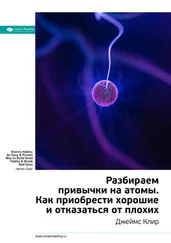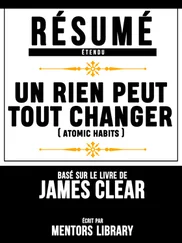CONCLUSION
No one can be rich unless one coin can make him or her so :Desiderius Erasmus and Van Loon Hendrik Willem, The Praise of Folly (New York: Black, 1942), 31. Hat tip to Gretchen Rubin. I first read about this parable in her book, Better Than Before, and then tracked down the origin story. For more, see Gretchen Rubin, Better Than Before (New York: Hodder, 2016).
LITTLE LESSONS FROM THE FOUR LAWS
“Happiness is the space between one desire” :Caed (@caedbudris), “Happiness is the space between desire being fulfilled and a new desire forming,” Twitter, November 10, 2017, https://twitter.com/caedbudris/status/929042389930594304.
happiness cannot be pursued, it must ensue :Frankl’s full quotation is as follows: “Don’t aim at success. The more you aim at it and make it a target, the more you are going to miss it. For success, like happiness, cannot be pursued; it must ensue, and it only does so as the unintended side effect of one’s personal dedication to a cause greater than oneself or as the by-product of one’s surrender to a person other than oneself.” For more, see Viktor E. Frankl, Man’s Search for Meaning: An Introduction to Logotherapy (Boston: Beacon Press, 1962).
“He who has a why to live for can bear almost any how” :Friedrich Nietzsche and Oscar Levy, The Twilight of the Idols (Edinburgh: Foulis, 1909).
The feeling comes first (System 1) :Daniel Kahneman, Thinking, Fast and Slow (New York: Farrar, Straus and Giroux, 2015).
appealing to emotion is typically more powerful than appealing to reason :“If you wish to persuade, appeal to interest, rather than reason” (Benjamin Franklin).
Satisfaction = Liking − Wanting :This is similar to David Meister’s fifth law of service businesses: Satisfaction = perception − expectation.
“Being poor is not having too little, it is wanting more” :Lucius Annaeus Seneca and Anna Lydia Motto, Moral Epistles (Chico, CA: Scholars Press, 1985).
As Aristotle noted :It is debated whether Aristotle actually said this. The quote has been attributed to him for centuries, but I could find no primary source for the phrase.
ABCDEFGHIJKLMNOPQRSTUVWXYZ
Index
The page numbers in this index refer to the printed version of this book. The link provided will take you to the beginning of that print page. You may need to scroll forward from that location to find the corresponding reference on your e-reader.
accepting that you have particular abilities, 218–19
accountability, 209–10
action vs. motion, 142–43
Adams, Scott, 23, 225
addiction
effect of environment on readdiction, 92
smoking, 125–26
Vietnam War heroin problem, 91–92
addition by subtraction strategy, 154
“the aggregation of marginal gains,” 13–14
agricultural expansion example of doing that which requires the least effort, 149–51
Allen Carr’s Easy Way to Stop Smoking (Carr), 125–26
amateurs vs. professionals, 236
animal behavior
within an immediate-return environment, 187
cat escape study, 43–44
greylag geese and supernormal stimuli, 102
herring gulls and supernormal stimuli, 101–102
methods for sensing and understanding the world, 84
Art & Fear (Bayles and Orland), 142n
Asch, Solomon, 118–20
athletes
Career Best Effort program (CBE), 242–44
comparing champions of different sports, 217–18
examples of reflection and review, 244–45
handling the boredom of training, 233–34
Los Angeles Lakers example of reflection and review, 242–44
use of motivation rituals, 132–33
atomic habits
cumulative effect of stacking, 251–52
defined, 27
automaticity, 144–46
automating a habit
cash register example, 171–72
table of onetime actions that lock in good habits, 173
Thomas Frank example of automating a habit contract, 210
using technology, 173–75
awareness
Habits Scorecard, 64–66
of nonconscious habits, 62
Pointing-and-Calling subway safety system, 62–63
bad habits
breaking (table), 97, 137, 179, 213
reducing exposure to the cues that cause them, 94–95
behavior change
Cardinal Rule of Behavior Change, 186, 189
four laws of, 53–55, 186, 252–53 ( see also specific numbered laws)
learning curves, 145–46
three layers of, 29–31
benefits of habits, 46–47, 239
“Better All the Time” (article), 154
biological considerations
“Big Five” personality traits, 220–22
genes, 218–21, 226–27
boredom, 233–36
Brailsford, Dave, 13–14
the brain
career choices and brain differences, 143–44
dopamine-driven feedback loops, 105–108
evolutionary similarity of, 187
as habits are created, 45–46
Hebb’s Law, 143
inaccurate perceptions of threats, 189n
long-term potentiation, 143
physical changes in the brain due to repetition, 143–44
System 1 vs. System 2 thinking, 232n, 261
“wanting” vs. “liking” rewards, 106–108, 263
breakthrough moments
ice cube melting example, 20–21
British Cycling, 13–15, 25, 243
Budris, Caed, 260
building a habit
four-step process
1. cue, 47–48
2. craving, 48
3. response, 48–49
4. reward, 49
problem phase and solution phase, 51–53
lessons from, 259–64
business applications of habit strategies, 265
Byrne, Ronan, 108–109
cash register example of automating a habit, 171–72
cat escape study, 43–44
changing your mind-set from “have to” to “get to,” 130–31
Cho, Margaret, 210
choosing the right opportunities
combining your skills to reduce the competition, 225–26
explore/exploit trade-off, 223–25
importance of, 222–23
specialization, 226
Clark, Brian, 33
commitment devices, 170–71
compounding effect of small changes
airplane route example, 17
author’s college experiences, 6–7
negative results, 19
1 percent changes, 15–16, 17–18
positive results, 19
conditioning, 132–33
consequences of good and bad habits, 188–90, 206–207
context, 87–90
cravings
as the sense that something is missing, 129
timing of, 259, 263–64
and underlying motives, 127–28, 130
cue-induced wanting, 93–94
cues
automatically picking up, 59–62
making predictions after perceiving, 128–29
obvious visual cues, 85–87
as part of the four-step process of building a habit, 47–48
selecting cues for habit stacking, 77–79
culture
imitation of community habits and standards, 115–18
Nerd Fitness example of similarity within a group, 117–18
Polgar family chess example of the role of, 113–14, 122
curiosity, 261
Damasio, Antonio, 130
Darwin, Charles, 115
decision journal, 245
decisive moments, 160–62
desire, 129–30, 263–64
Diderot, Denis, 72–73
Diderot Effect, 73
“don’t break the chain,” 196–97
dopamine-driven feedback loops, 105–108
downside of habits, 239–40
Dyrsmid, Trent, 195
emotions, 129–30, 261–62, 263–64
energy and likelihood of action, 151–52
Читать дальше
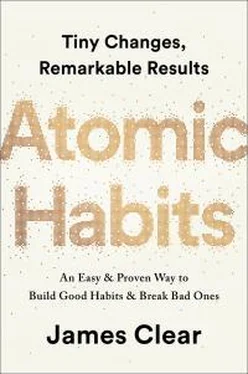

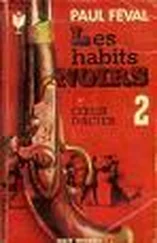
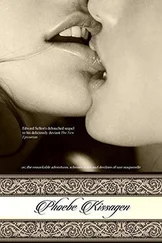
![Джеймс Клир - Атомные привычки [Как приобрести хорошие привычки и избавиться от плохих]](/books/403243/dzhejms-klir-atomnye-privychki-kak-priobresti-horosh-thumb.webp)

